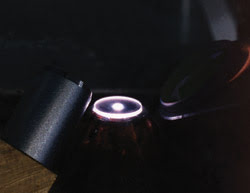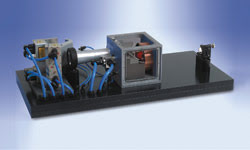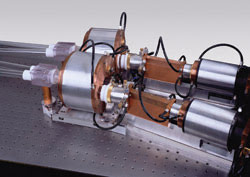Nadya Anscombe, Contributing Editor
Thin-disc geometry, Yb:YAG technology and more powerful diode pumps have combined to produce a new generation of solid-state lasers with an eye on the Nd:YAG laser’s market supremacy.
If asked to name a solid-state laser, most
people would mention the Nd:YAG. This trusty combination of neodymium and yttrium
aluminum garnet has served industry well for many years. The YAG crystal has the
highest thermal conductivity and fracture resistance available, assuring its future
as a medium for solid-state lasers. Neodymium’s monopoly as a dopant, however,
is threatened by the arrival of new materials in solid-state lasers emerging in
Europe — namely, ytterbium used in Yb:YAG lasers.
These powerful devices, based on thin-disc geometry,
have many advantages over their Nd:YAG cousins (see YAG vs. YAG). But they are only
now entering the market because they require high-power pump diodes with high beam
quality that, until recently, have been unavailable. After many years, single-disc
Yb:YAG lasers are finally achieving output powers up to 1.5 kW, a prerequisite for
many industrial and research applications.

Thin-disc Yb:YAG lasers have begun to emerge in the wake of high-power
pump diodes with sufficient beam quality. Advances in diode pumps have enabled single-disc
Yb:YAG lasers to deliver up to 1.5 kW. Courtesy of the University of Stuttgart.
Invented by Adolf Giesen and his group
at the University of Stuttgart in Germany, the Yb:YAG is taking off in Europe but
has made very few inroads in the US. There are more than 10 suppliers of Yb:YAG
lasers in Europe, but none in the US. This is no accident: The German body that
funded Giesen’s original work laid down strict guidelines as to where the
technology could be licensed.
“We are only allowed to license
the technology outside Germany if this presents no competition to our German licensees,”
Giesen said. His group licensed the technology to approximately 15 companies, two
in the US. For confidentiality reasons, he could not name the companies, and he
declined comment as to when the restrictions might be lifted.
Interest in Yb:YAG lasers stems from
the many advantages of thin-disc technology compared with diode-pumped rod-based
Nd:YAG systems. These include superior beam quality, efficiency and tunability.
But Giesen does not think the thin-disc Yb:YAG will replace Nd:YAG rod lasers in
all applications.
“This new technology will enable
new markets such as the high-speed welding of thin sheets of steel and welding with
robots,” he explained. “Because the beam quality is much better than
conventional solid-state lasers, the optics needed are much smaller. This will enable
the lasers to be used on robots deep inside car bodies, for example.”
Elektronik Laser System GmbH (ELS),
near Frankfurt, Germany, was one of the first companies to offer a commercially
available Yb:YAG thin-disc laser. This small firm’s confidence in Yb:YAG technology
is apparent in that it is the only solid-state laser technology the company offers
in its product range. Its VersaDisc line produces output powers from 10 to 100 W
and targets industrial and research applications. The company claims its laser has
a perfect Gaussian beam intensity distribution and that higher power levels are
possible by changing pump sources. Its novel pumping geometry directs the pump beam
24 times through the crystal, providing a long effective absorption length without
the negative effects associated with conventional rod-based solid-state lasers.
ELS planned to launch a frequency-doubled
version in October, according to CEO Günter Hummelt. “This emits more
than 5-W output power at 515 nm, and applications for the laser include spectroscopy,
interferometry, printing and holography.” He added that it is ideally suited
to pump Ti:sapphire lasers because the emission wavelength fits perfectly with the
absorption of the Ti:sapphire crystal.
The company’s mode-locked version
could be available by spring. The fundamental line at 1030 nm generates subpicosecond
pulses with expected peak powers up to 50 MW.
ELS aims mainly for research markets,
where it has sold several systems. The area where Yb:YAG lasers have the most potential,
however, is the industrial market. German manufacturer Rofin-Sinar Laser GmbH of
Hamburg agrees that these lasers will open new industrial markets rather than replace
Nd:YAG systems.

For now, the lower output powers of thin-disc Yb:YAGs make them less likely to compete in established
Nd:YAG instruments markets. Instead, some Yb:YAG vendors are aiming for the engraving and printing markets. Courtesy of Rofin-Sinar Laser GmbH.
“We will have a product on the
market in the next six months and we are aiming it at the engraving and printing
industries,” said CEO Peter Wirth. “Our Yb:YAG laser has an output power
of 500 W. For higher-power applications, we have our diode-pumped solid-state rod
lasers.”
Trumpf Laser GmbH in Schramberg, Germany,
has a different strategy. “If the cost of the pump laser diodes decreases,
there is no reason why the market for thin-disc Yb:YAG laser systems should not
be as big as the current diode- and lamp-pumped continuous-wave Nd:YAG markets,”
said Kurt Mann, sales and marketing manager. “We believe the Yb:YAG laser
could eventually replace the Nd:YAG laser in all continuous-wave applications.”

If the cost of diode pumps continues to drop and output powers continue to rise, thin-disc Yb:YAG
instruments may begin to steal market share from Nd:YAGs in high-power industrial applications. Commercial two-disc lasers already can reach output powers of up to 1.5 kW, and advocates speculate that these lasers will deliver 10 kW from a single disc. Courtesy of Trumpf Laser GmbH.
But generally, Yb:YAG suppliers are targeting applications where customers need a higher beam quality than Nd:YAG systems can deliver.
In September, Trumpf — formerly
Haas Laser — sold its first Yb:YAG system, which will be used in a fine-welding
application. “This is a two-disc system that can reach output powers of up
to 1.5 kW,” Mann said. “The beam quality is so good that it can be delivered
to the workpiece using a 150-μm-diameter fiber. The beam quality of a conventional
rod laser decreases with increasing output power. The disc laser, on the other hand,
does not suffer so strongly from the thermal lensing effect, so its beam quality
stays high during increasing powers.”
And the output powers of thin-disc
Yb:YAG lasers may increase. Mann believes that it is only a matter of time until
4-kW thin-disc lasers challenge the dominance of conventional lamp-pumped solid-state
lasers.
Giesen believes even higher powers
are achievable. “Computer simulations have shown that it is possible to get
10 kW out of a single disc,” he said. “Some companies today have achieved
1.5 kW from a single disc, and I think we will soon be able to achieve 10 kW. To
achieve this, however, we need higher-power pump laser diodes. For a 5-kW laser
with an efficiency of 60 percent, we need 8- to 10-kW pump power, and this is not
available.”
But not everyone is aiming for such
high powers and not everyone is convinced about the advantages of Yb:YAG materials.
Jenoptik Solid Laser GmbH in Idar-Oberstein, Germany, has two thin-disc laser product
lines, an 8-W Q-switched Nd:YAG and a 5-W frequency-doubled Nd:YVO4 system. Neither
is based on Yb:YAG technology.
“We chose these chemistries because
frequency doubling is not possible on an Yb:YAG system without additional optical
elements, and Q-switching cannot be done over a wide enough frequency range,”
said product manager Holger Müller.
Jenoptik’s compact air-cooled
lasers are designed for several applications, including the medical and display
industries. And the company has had much success, judging from the fact that it
donated its 1000th system to Adolf Giesen.
So it seems that European firms have
a head start in the development of what many see as the next generation of solid-state
lasers. Arnold Mayer, an analyst at Optech Consulting in Taegerwilen, Switzerland,
says it is impossible to predict how the market will react to the Yb:YAG laser.
“It is too soon to say if the
Yb:YAG laser will replace the diode-pumped Nd:YAG laser in all applications,”
he said. “I think there are three contenders for this part of the laser market:
Nd:YAG, Yb:YAG and the fiber laser. Whichever one succeeds will take over a global
market worth more than $1 billion.
How Thin-Disc Yb:YAG Lasers Work
The thin-disc Yb:YAG laser combines two ideas into one powerful laser:
thin-disc geometry, which gives high beam quality at high powers, and Yb:YAG crystal,
which can be pumped with 940-nm diodes. Yb:YAG crystals also have a longer upper-state
lifetime than their neodymium-doped counterparts.
 As their name suggests, thin-disc lasers use crystals
shaped into discs that are typically 200 nm thick and 10 mm in diameter. A diode
laser quasi-end-pumps the disc on one of its faces while a heat sink on its other
face provides cooling. A compact mirror system passes light through the crystal
many times to generate high absorption. The coated back side of the crystal acts
as an end mirror in the laser resonator.
As their name suggests, thin-disc lasers use crystals
shaped into discs that are typically 200 nm thick and 10 mm in diameter. A diode
laser quasi-end-pumps the disc on one of its faces while a heat sink on its other
face provides cooling. A compact mirror system passes light through the crystal
many times to generate high absorption. The coated back side of the crystal acts
as an end mirror in the laser resonator.
One advantage of the disc geometry
is that cooling runs parallel to the direction in which the laser beam spreads (i.e.,
in an axial direction). This gives only a small radial temperature gradient and
prevents much of the beam distortion from which most other solid-state lasers suffer.
The geometry also means that the laser has a large ratio of surface area to volume,
allowing efficient cooling.
YAG vs. YAG
It is possible to make rod lasers with Yb:YAG crystals and thin-disc
lasers with Nd:YAG crystals, but combining Yb:YAG with thin-disc geometry has many
advantages.
Beam quality: A typical 1- to 5-kW
rod laser has M2 between 60 and 100. A comparable thin-disc laser has M2 between
15 and 18; lower-power disc lasers can have M2 of 1.
Repetition rate: Ytterbium’s
upper-laser level has a relatively long (1 ms) lifetime and allows significantly
higher repetition rates than Nd:YAG lasers.
Tunability: The amplification bandwidth
of Yb:YAG lasers is an order of magnitude larger than the amplification bandwidth
of Nd:YAGs. The Yb:YAG lasers are also tunable, in theory, from 1020 to 1060 nm.
Wavefront distortion: Thermal gradients
in a Yb:YAG instrument are aligned with the beam propagation direction, resulting
in fewer wavefront distortions.
Pumping: The energy difference between
ytterbium’s emission and absorption bands is small, reducing the amount of
pump power that is lost as heat.
Absorption: Ytterbium’s absorption
maximum is near 940 nm, making it suitable for pumping with InGaAs diodes.
Wall-plug efficiency: Ytterbium’s
efficiency is typically four to five times higher than that of other solid-state
lasers.
Quantum efficiency: Ytterbium has no
loss mechanisms, such as up-conversion, so it can operate at high efficiencies.
Footprint: Disc geometry enables a
compact design, and high beam quality allows the use of more compact optics.